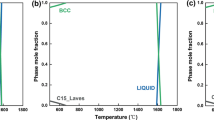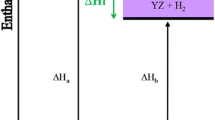Abstract
The hydrogen storage properties of a series of mechanically alloyed (MA) amorphous Ni1xZrx alloys are studied, using both gas phase and electrochemical techniques, and are compared to H storage of rapidly quenched (RQ) amorphous Ni1−xZrx. In the MA alloys, hydrogen resides in the Ni4−nZrn (n = 4,3,2) tetrahedral interstitial sites, with a maximum hydrogen-to-metal ratio of 1.9(4 n)xn(1 − x)4 − n. These features are identical to those of the RQ alloys and indicate that the topological and chemical order of the MA and RQ materials are essentially the same. However, the typical binding energy of hydrogen in a Ni4−nZrn site, En, is shifted in the MA alloys relative to the RQ alloys and the distribution of binding energies centered on En is significantly broader in the MA samples. Thus, the MA and RQ alloys are not identical and sample annealing does not alter this subtle distinction. The sensitivity of H storage to the presence of chemical order in binary alloys are analyzed theoretically and the data are found to be most consistent with little or no chemical order (random alloys).
Similar content being viewed by others
References
E. Hellstern and L. Schultz, Appl. Phys. Lett. 48, 124 (1986).
R. Bruening, Z. Altounian, J. O. Strom-Olsen, and L. Schultz, in the Proceedings of the 6th International Conference on Rapidly Quenched Metals (Elsevier, New York, 1988).
A. W. Weeber, K. Van der Meer, H. Bakker, F. R. deBoer, B. J. Thijsse, and J. F. Jongste, J. Phys. F: Met. Phys. 16, 1897 (1986).
L. Schultz, E. Hellstern, and A. Thomae, Europhys. Lett. 3, 921 (1987).
E. Hellstern and L. Schultz, Appl. Phys. Lett. 49, 1163 (1986).
C. C. Koch, O. B. Cavin, C. G. McKamey, and J. O. Scarbrough, Appl. Phys. Lett. 43, 1017 (1983).
B. P. Dolgin, M. A. Vanek, T. McGory, and D. J. Ham, J. Non-Cryst. Solids 87, 281 (1986).
J. H. Harris, W. A. Curtin, and M. A. Tenhover, Phys. Rev. B 16, 5784 (1987).
W. A. Curtin and J. H. Harris, in Ref. 2.
C. M. Luedecke, G. Deublein, and R. A. Huggins, J. Electrochem. Soc. 132, 52 (1985).
K. Aoki, A. Horata, and T. Masumoto, in Proceedings of the 4th International Conference on Rapidly Quenched Metals, edited by T. Masumoto and K. Suzuki (Japan Institute of Metals, Sendai, 1982), p. 1649.
R. Kirchheim, Acta Met. 29, 835 (1981).
J. M. Cowley, Diffraction Physics (North-Holland, Amsterdam, 1975).
As discussed in Ref. 8 for the random alloy model, it is extremely important to show that blocking interactions considerably alter the number of A 4−n Bn sites which can be occupied, but only in an x- and n-independent manner. Thus, the random alloy statistics xn (1 − x)4−n are preserved but with a prefactor Neff ≃ 1.9 that is much smaller than the total number of tetrahedral interstitial sites per atom, which is in the range of 5–6. With CSRO, the total number of A 4 − n Bn sites is altered and, in principle, the detailed blocking effects are also modified, which could partially cancel CSRO effects on the H storage. Our simulation results on H storage in the tetrahedral sites of bcc A 1 − x Bx alloys show blocking effects to be modified only very slightly in comparison to the variations in the total number of tetrahedra. Hence, modification to H storage from modified blocking at finite α are neglected in our analysis.
A. Lee, G. Etherington, and C. N. J. Wagner, J. Non-Cryst. Solids 61 and 62, 343 (1984).
Author information
Authors and Affiliations
Rights and permissions
About this article
Cite this article
Harris, J.H., Curtin, W.A. & Schultz, L. Hydrogen storage characteristics of mechanically alloyed amorphous metals. Journal of Materials Research 3, 872–883 (1988). https://doi.org/10.1557/JMR.1988.0872
Received:
Accepted:
Published:
Issue Date:
DOI: https://doi.org/10.1557/JMR.1988.0872




